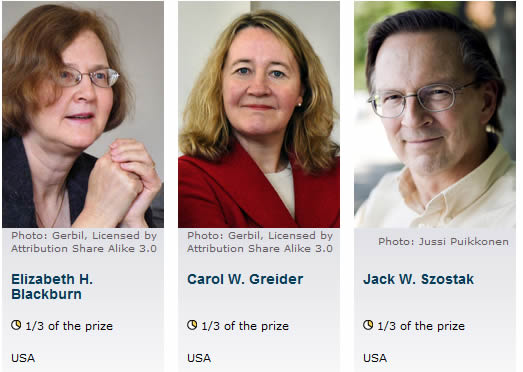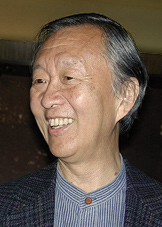Nobel Prize 2009 Physics and Medicine - All Americans
Nobel Prize foundation announced the 2009 winners in Medicine and Physics.
Medicine
 |
| A screen Capture Showing the Winners of Nobel Prize in Medicine. Image Courtesy: Nobel Prize Foundation |
The Official website of Nobel Prize Foundation says -
The Nobel Assembly at Karolinska Institutet has today decided to award The Nobel Prize in Physiology or Medicine 2009 jointly to Elizabeth H. Blackburn, Carol W. Greider and Jack W. Szostak for the discovery of "how chromosomes are protected by telomeres and the enzyme telomerase"
Elizabeth Blackburn from the University of California, San Francisco, Jack Szostak from Harvard Medical School and Carol Greider from Johns Hopkins University all share this year's Nobel prize for medicine.
Technicalities
Human genes are packed into chromosomes, which are capped by telomeres. Telomeres get shorter each time a cell divides — except in cells with the telomerase enzyme. When the caps get too short, the cell can’t divide anymore and dies. While the telomerase enzyme isn’t active in most human cells, which stop reproducing and eventually die, it has been found in cancer cells, the Nobel committee for the medicine prize said in a statement on its Web site.
The key is the end of the chromosome, where caps known as telomeres reside. An enzyme discovered by the researchers, dubbed telomerase, prevents the end from being shaved off and maintains the health of the cell as it replicates -- earning it the title of “immortality enzyme.”
U.S. drugmaker Merck & Co. and Menlo Park, California- based biotechnology company Geron Corp. began testing a cancer vaccine that targets telomerase last year in patients with solid tumors, including lung and prostate cancer. Geron is also testing another telomerase inhibitor in breast and plasma cell cancer patients.
Physics
 The official Nobel Prize Website says
The official Nobel Prize Website says
The Royal Swedish Academy of Sciences has decided to award the Nobel Prize in Physics for 2009 with one half to Charles K. Kao Standard Telecommunication Laboratories, Harlow, UK, and Chinese University of Hong Kong "for groundbreaking achievements concerning the transmission of light in fibers for optical communication" and the other half jointly to Willard S. Boyle and George E. Smith Bell Laboratories, Murray Hill, NJ, USA "for the invention of an imaging semiconductor circuit – the CCD sensor"
Three scientists who created the technology behind digital photography and helped link the world through fiber-optic networks shared the 2009 Nobel Prize in physics Tuesday.
Charles K. Kao was cited for his breakthrough involving the transmission of light in fiber optics while Willard S. Boyle and George E. Smith were honored for inventing an imaging semiconductor circuit known as the CCD sensor. The Royal Swedish Academy of Sciences said all three have American citizenship. Kao also holds British citizenship while Boyle is also Canadian. The award's 10 million kronor ($1.4 million) purse will be split between the three with Kao taking half and Boyle and Smith each getting a fourth. The three also receive a diploma and an invitation to the prize ceremonies in Stockholm on Dec. 10.
Light-Fibers-Sensors
This year's Nobel Prize in Physics is awarded for two scientific achievements that have helped to shape the foundations of today’s networked societies. They have created many practical innovations for everyday life and provided new tools for scientific exploration. In 1966, Charles K. Kao made a discovery that led to a breakthrough in fiber optics. He carefully calculated how to transmit light over long distances via optical glass fibers. With a fiber of purest glass it would be possible to transmit light signals over 100 kilometers, compared to only 20 meters for the fibers available in the 1960s. Kao's enthusiasm inspired other researchers to share his vision of the future potential of fiber optics. The first ultrapure fiber was successfully fabricated just four years later, in 1970.
If we were to unravel all of the glass fibers that wind around the globe, we would get a single thread over one billion kilometers long – which is enough to encircle the globe more than 25 000 times – and is increasing by thousands of kilometers every hour. A large share of the traffic is made up of digital images, which constitute the second part of the award. In 1969 Willard S. Boyle and George E. Smith invented the first successful imaging technology using a digital sensor, a CCD (Charge-Coupled Device). The CCD technology makes use of the photoelectric effect, as theorized by Albert Einstein and for which he was awarded the 1921 year's Nobel Prize. By this effect, light is transformed into electric signals. The challenge when designing an image sensor was to gather and read out the signals in a large number of image points, pixels, in a short time.
